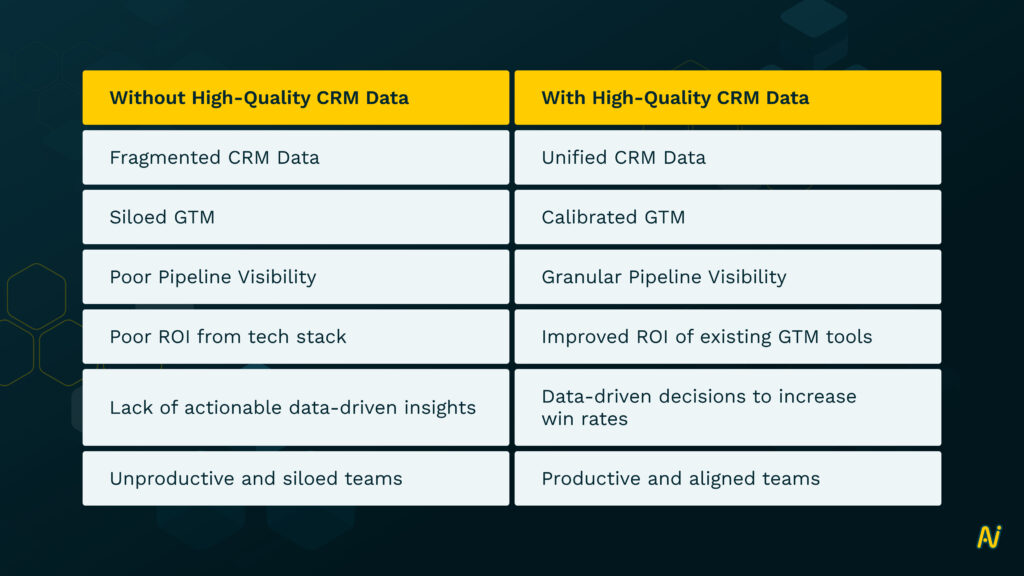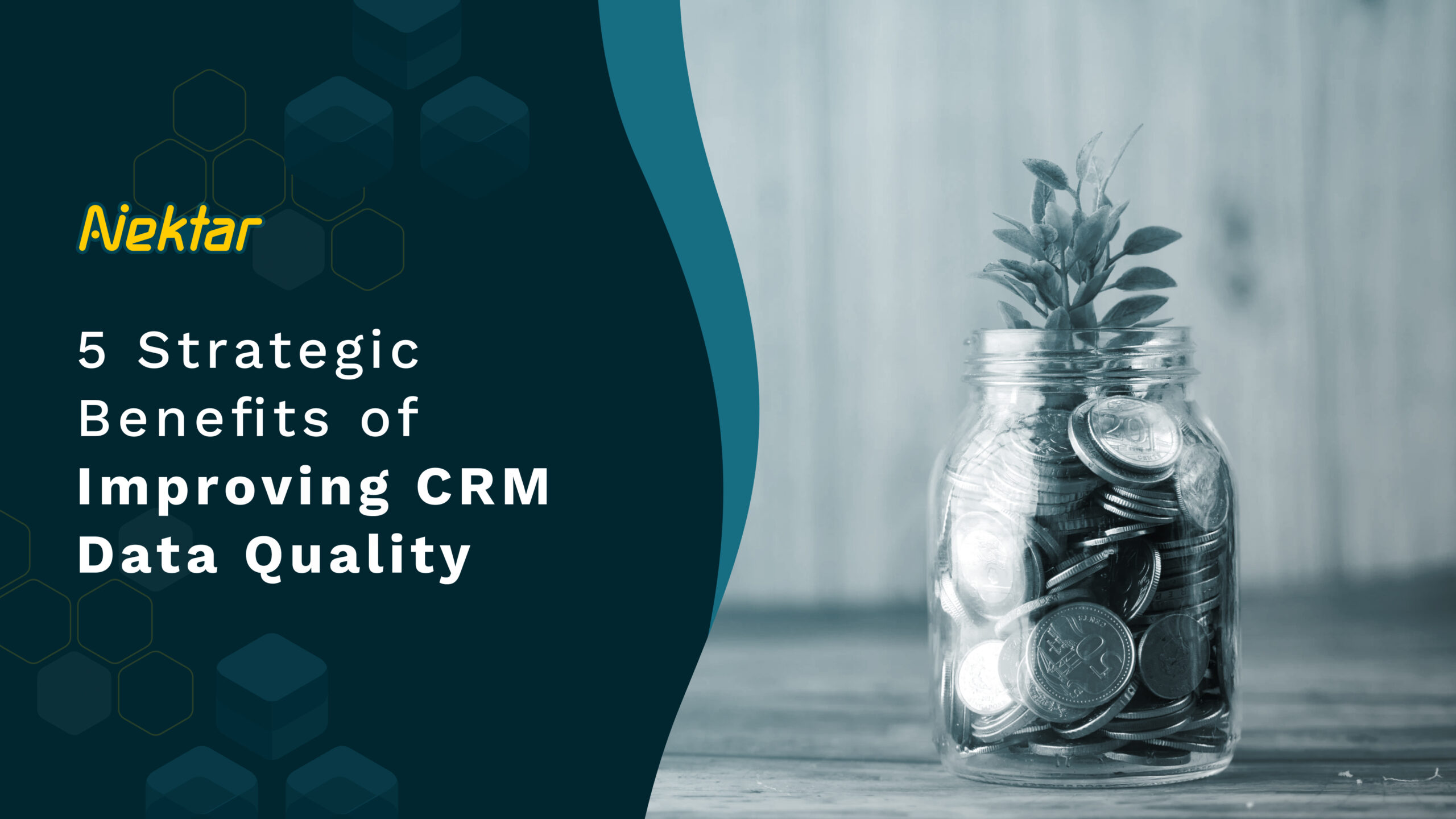The market for CRM systems is exploding. The global market for CRMs is expected to reach $63.91 billion this year. While this says a lot about the increasing demand for CRMs, it does not give a true picture of how valuable CRMs really are.
When it comes to realizing the true value of a CRM system, it’s not about the CRM itself. It is about the quality of data that resides in it. Despite this fact, CRM data quality continues to be a significant challenge for businesses. As a result, they fail to harness the true ROI that CRMs promise to bring with it.
What kind of quality issues does CRM data face? For starters, 91% of CRM data is incomplete, stale or duplicated each year. And 70% of the data in a CRM decays annually. These inefficiencies wreak havoc on a company’s bottom line, costing companies over 10% of their annual revenue!
This problem keeps increasing as more data gets added to a CRM system over time. And before you know it, your CRM turns into a mess with piles of dirty data that adds no value to your business.
Improving and enriching data quality is the first step to realizing a CRM’s true potential. High quality CRM data can open multiple doors for any revenue leader to steer their businesses forward, no matter how the waters are outside. It is a solid foundation that can protect businesses from uncertainties like downturns, recession etc.
This article will take you through some of the perils of poor quality data in your CRM. And some top use cases of high quality CRM data driving ROI for a business.
Low Quality CRM Data Leads to High Costs
According to Gartner, poor data quality makes organizations lose an average of $15 million per year.
The obvious cost of poor quality CRM data comes with paying extra for CRM storage containing stale, incorrect or missing data. But there are also a lot of hidden costs that might be causing serious revenue leakage such as:
- Increased cost per customer
- Lower conversion rates
- Reduced revenue
- Dip in profits
Forrester Research has found that the persistence of low-quality data throughout enterprise systems robs business leaders of productivity, as they must continuously vet data to ensure it remains accurate. Ignoring these side effects of poor quality data can cause irreparable damages to revenue generation in the long term.
To put it simply, any business decision made with poor quality data becomes risky. Be it your marketing campaigns, sales and marketing alignment, pipeline overview or details about your buying committee, poor quality data gives you an even poorer view of your business in all these critical areas.
Such data inefficiencies are causing revenues to leak through your funnel in myriad ways. Some of them include:
1. Frustrated sales reps
53% of salespeople have a love/hate relationship with their CRM. They hate manual data entry. 64% of sales teams say they would leave their current role if organizations don’t invest resources in a CRM data quality plan.
CRM systems are taking away valuable productive hours from your sales reps which can be spent on building relationships with customers. This has a direct impact on their quota and makes selling harder for them than it already is.
2. Incorrect sales forecasting
An accurate sales forecast allows revenue leaders to allocate resources efficiently and maximize returns for the future. But poor quality data leads to incorrect forecasts that can lead to massive revenue leakage. The result is wasted resources on avenues that lead to no result.
3. Poor ROI from CRM
CRM systems continue to be one of the biggest investments for businesses. But most businesses fail to extract maximum value out of this investment because CRM data is riddled with inefficiencies. With more time, CRMs end up becoming a major source of revenue drain, and end up adding little to no value to overall business goals.
4. Failed marketing campaigns
In an era where customers demand real-time and personalized messaging, relying on poor quality CRM data to drive such campaigns can end up as disasters. Bad data leads to a string of campaign failures that can damage the reputation of a brand. For example, basing a marketing campaign on a list of stale contacts only ends up spending money on an idea that will never convert.
How To Improve CRM Data Quality
Having high-quality CRM data addresses and fixes revenue leakage at its roots. For revenue leaders who want to set up systems, processes and operations that lead to GTM alignment, the first-step is to fix the CRM data quality problem.
And to make sure the data in your CRM is trustworthy, complete and accurate, you must invest in technology that does not put additional pressure on your sales, marketing or customer success teams. Instead, it must enable them to do their job better while the tool silently works its magic in the background.
A great example in point here is CRM data entry. It continues to be a largely manual exercise, taking away so much time from sales reps. Manual data entry also leads to higher chance of error in data entry or missing to enter key information that could lead to more deals.
What needs to be done here is not only find a way that automates CRM data entry, but also enriches that data from various GTM tools like CRM systems. This way GTM teams always have correct and updated data to work with. And with a layer of intelligence added on top of this clean data can drive revenue teams towards successful scaling initiatives.
5 Strategic Benefits of Improving CRM Data Quality
Fixing your CRM data quality can have a direct impact on your bottom line and fix several unknown revenue gaps.
Here are some use top cases we have seen on how actionable insights from superior CRM data quality has helped revenue teams create a predictable and scalable revenue engine.
1. Accurate visibility of GTM funnel
To accelerate pipeline development, your frontline sales, marketing and customer success teams need to work together with high-quality CRM data.
With CRM data that is accurate and reliable, your GTM funnel is aligned and the entire organization refers to a single set of data-driven insights to work towards common goals.
With this kind of data-driven alignment, a lot of leakages get addressed at the root level. All your customer-facing teams have better visibility across the sales pipeline. You have better insights into the health of your pipeline, and everyone has answers to key questions like:
- How many qualified leads are there in the pipeline?
- Which contacts are most likely to engage with your sales or marketing efforts?
- Which leads should you disqualify?
For example, if the sales team notices that an important deal is stuck at a particular stage in the pipeline, and insights tell you that sharing a case study at that stage makes it more likely to accelerate the deal, they can work with marketing to get the same done. In this example, sales and marketing can work together with a common goal of moving a deal from one stage to another. And both can see the impact of their collaboration in the pipeline.
Marketing can be sure of the leads they pass on to sales. Your chances of generating more qualified leads increases. For example, you can capture missing contacts that can indirectly help your inside sales team as they are able to reach out to all those additional contacts in account. These people which you previously didn’t even know about can now be reached out to and potentially closed.
2. Increased focus on deals that convert
Your sales pipeline might get bloated with opportunities over time that add little to no value to your revenue. This can happen when your sales reps do not want to eliminate any deal opportunity, even if no conversations have happened in a long time.
Your reps might also believe that the bigger their pipeline, the more value it holds. However, the truth is that the more time reps spend on deals that have no future, the less is their quota attainment. Every minute spent on an unreal deal is time taken away from a deal that could close.
With complete and accurate CRM data, you can generate insights that tell you exactly which deals need to be eliminated from the pipeline so that your teams can divert their resources towards the most critical accounts.
Insights generated from accurate and complete CRM data gives sales managers a clear picture of where the pipeline looks bloated. They can take quick action on stalled deals and decide how to drive predictable quarters for themselves.
For example, by tracking the activity data of your reps in the CRM, you can use it as a leading indicator to determine which deals are real and focus only on those that convert.
3. High engagement with the buying committee
Selling is all about relationships. Making relationships with the customer, and nurturing them with time. But the buyer is no longer a single person in B2B sales. According to Gartner, the number of buyers in a group has increased from 5 to 20 in the last ten years.
63% of these key stakeholders are outside the IT department. Not just this, 80% of sales reps lose a deal when a key stakeholder quits their job.
As a result, it’s harder for sellers to validate the key stakeholders in the buying group, let alone engage with each of them.
Sellers not only need to know all the members in the buying committee, they also need to know which ones are the decision makers. And without the right data, sellers are left scrambling to identify who they should actually be pitching to in a buying group.
The result is lost deals, poor outreach and wasted hours on making ppt’s that are sent to the wrong person altogether!
Data and intelligence on your key buyers is a critical part of creating and maintaining strong relationships with your accounts. The right data can help your sellers get visibility into the personas that need to be targeted to fully influence the buying group at an account or opportunity level. The real challenge is finding the data, capturing it and quickly putting the pieces together for your teams to see.
For example, tools like Nektar help capture and match contact information to the corresponding opportunity automatically. This has a huge impact on who you target in the buying committee and how you engage with them. Sales teams can quickly and easily uncover answers to the questions they need to predict revenue and accelerate deals.
4. Hyper-personalized ABM campaigns
The days of “spray and pray” in marketing are over. Today’s buyers expect messaging that is customized to their unique pain points. They want solutions at their preferred time and choice of medium (digital channels or in-person).
According to Forrester, 60% of buyers say sellers who are knowledgeable and address their needs have the most positive impact on their buying decisions. And a study by Infosys found that 86% of consumers say personalization plays a role in their purchasing decisions.
Personalized campaigns are proven ways of increasing revenues by 5 to 15 percent and increasing market spend efficiency by 10 to 13 percent. As per McKinsey, personalization will be the prime driver of marketing success. Organizations that know how to segment their audiences and build robust account-based marketing campaigns to capture and nurture them will emerge successful.
But building powerful ABM campaigns relies heavily on CRM data quality. And data remains an obstacle to do personalization right. A majority of revenue leaders from our survey don’t feel confident in their ability to create personalized, omnichannel buying experiences at scale. As less as 15% of CMOs believe their company is on the right track with personalization.
Such data quality shortcomings in CRMs are making marketing and sales teams underperform and fail on their personalized outreach strategies. With good quality and trustworthy CRM data, GTM teams can access greater intelligence and accuracy when it comes to their personalization efforts.
Mass emails will get replaced by lower volume, but more targeted approaches. With the right data strategy, sales and marketing teams can invest in what converts and not just what clicks.
Organizations can use enriched data in their CRM to reach each segment of their customer base with a meaningful omni-channel approach and successfully execute ABM strategies at scale. Clean CRM data with AI-led revenue intelligence can facilitate this kind of strategy and engage high-potential prospects.
5. Reduced operational cost of bad data
The more dirty data you collect, the more problems your database will create. This bad data causes severe revenue losses like high customer churn, failed marketing campaigns, and lower productivity among your teams. This cost in the US alone is $3.1 trillion annually, while individual organizations can lose $9.7 million per year.
The quality of your CRM data will have a direct impact on the costs of maintaining it. As your data continues to grow, its management costs grow exponentially along with it. Data cleansing in itself can be a huge financial burden for your business. Data scientists spend 80% of their time cleaning data rather than creating insights.
Clean data can clear a lot of such operational costs that come with management of bad data. For example, using inaccurate data to drive ABM campaigns can lead to higher customer churn, a higher probability of emails bouncing or targeting the wrong people altogether. This can increase operational costs by leaps and bounds in the form of acquiring returns on CRM investment or loss of productivity among your sales reps because of manual entry.
With clean and accurate data that automatically enters your CRM, and gets enriched as things move at lightning fast speed, you can reduce these operational risks and save more revenue.
Proper CRM data management is a continuous process in this regard. And it can reduce your storage costs by 7% and management costs by 5%. Your reps save enormous amounts of time from ditching manual entry by as high as 79% – which leads to increased productivity.

Recognize Immediate ROI With Superior CRM Data Quality
Customers demand a superior, personalized and differentiated experience in a shrinking window of opportunity that buyers provide to them for direct engagement. Capturing such “moments that matter” require access to actionable insights about customers that can help sales and marketing teams get more customers.
Your entire GTM strategy needs to focus on meeting these sky-high expectations of customers. But you need clean data in your CRM to make this happen. Insights from high quality CRM data can help revenue teams get insights in real-time to drive commercial results. They can also help you identify what to prioritize on your next steps that can give the highest returns.
To meet these customers where they are, insights from customer data must be delivered across the organization in real time. Revenue leaders are looking for better ways for these actionable insights from data to turn their customer data in systems like CRM into actionable commercial insights that inform decisions, actions and conversations in the “moments that matter.”
A truly digital data approach is one where frontline sales, marketing and customer success are working together with high quality CRM data to drive data-driven insights to find the next best customer.
The CRM data that revenue teams work with needs to be of high quality. By significantly improving the quality of your CRM data, you can maximize the ROI of not just your CRM system, but all your GTM tools.
Do not slow down your business with bad data.
How Nektar Fills The Missing CRM Data Quality Gap
Nektar helps you automatically capture critical revenue data that otherwise goes missing in your CRM. Our unified activity capture solution not only helps automate CRM data entry, but also enriches it so you never have to deal with bad data again.
Get immediate ROI from our no-code solution and explore the potential of your own first-party data to scale your business.
Get a free scan to see if you’re missing any key revenue data in your CRM.











